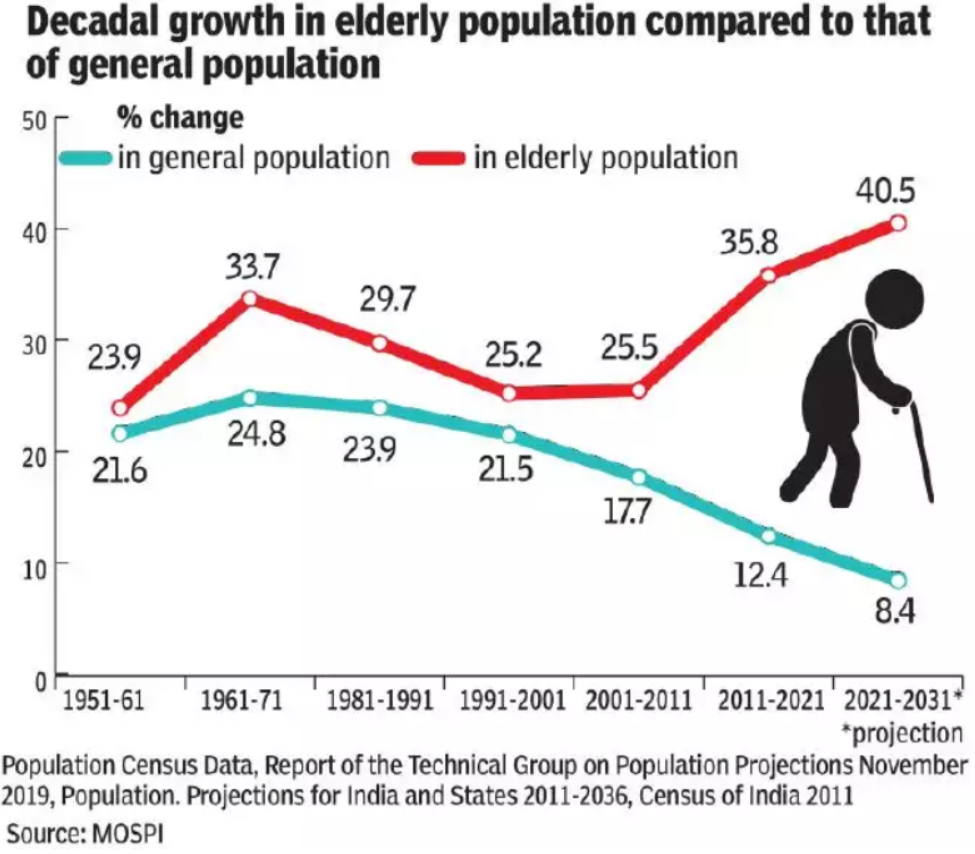CONTENTS:
- Caring for the old
- Lancet report on cancer in women
United Nations Population Fund’s India Ageing Report 2023
Context:
A significant portion of the global population is aging, and India reflects this trend. According to the United Nations Population Fund’s India Ageing Report 2023, the population aged 60 and above is projected to double from 10.5% or 14.9 crore (as of July 1, 2022) to 20.8% or 34.7 crore by 2050. This demographic shift, with one in five individuals being a senior citizen, will have implications for health, the economy, and society at large.

Relevance:
GS1- Population and Associated Issues
GS2-
- Government Policies & Interventions
- Health
- Issues Related to Elderly
- Human Resource
Mains Question:
As the proportion of the elderly population continues to rise, it becomes imperative to adopt proactive policies and initiatives that can effectively cater to the changing requirements of this demographic group. Examine. (15 marks, 250 words).
Elderly population across states in India:
- In certain regions like Kerala and West Bengal, there is a rising population of elderly individuals living alone as their children migrate for better opportunities.
- Significant interstate variations exist, with southern states reporting a higher share of the elderly population than the national average, and this gap is expected to widen by 2036.
- While states with higher fertility rates, such as Bihar and Uttar Pradesh, anticipate an increase in the elderly population, it is projected to remain lower than the national average.
Issues that elderly face:
- The increased life expectancy, coupled with declining fertility rates, poses challenges in caring for the expanding elderly population.
- Notably, women outnumber men among elderly citizens, and the life expectancy for women at 60 is higher than that of men.
- With a low labor force participation rate for women in India (24%), there is a concern that those lacking economic and social security may face increased vulnerability in old age.
- Over two-fifths of the elderly belong to the poorest wealth quintile, ranging from 5% in Punjab to 47% in Chhattisgarh. Additionally, 18.7% of the elderly have no income.
- A considerable portion of the rural population falls into the elderly category and often faces economic deprivation.
Conclusion:
Addressing the challenges requires a comprehensive “whole-of-society” approach, encompassing physical and mental health, basic needs like food and shelter, income security, and social care. Geriatric care should be tailored to their unique healthcare needs. Although there are several schemes targeting the elderly, many are unaware of them or find the sign-up process cumbersome. Existing policies, such as the National Policy on Older Persons (1999) and the Maintenance and Welfare of Parents and Senior Citizens Act (2007), outline care for the elderly. However, ensuring that senior citizens live in dignity requires public and private policies to create a more supportive environment.
Lancet Report on Cancer in Women
Context:
A recent report from the Lancet Commission on gender disparities in cancer care quantifies what has been known anecdotally, providing stark statistics.
Relevance:
GS2- Health
Mains Question:
Drawing from the findings of the recently released Lancet report on cancer in women, analyse the steps taken in this regard. Also suggest what should be done to effectively deal with cancer among women. (15 marks, 250 words).
Findings of the report- Global statistics:
- Although women bear a similar cancer burden as men, accounting for 48 percent of new cases and 44 percent of global cancer-related deaths, the impact on women is disproportionately higher.
- The commission’s report, titled “Women, Power and Cancer,” scrutinizes power imbalances in cancer-related decision-making, knowledge dissemination, and economic factors across 185 countries.
- The results are disheartening: cancer ranks among the top three causes of premature female deaths globally, and women face challenges in accessing necessary care due to limited knowledge and decision-making authority.
- The report highlights the insufficient research on the causes of breast cancer and the underexplored occupational and environmental hazards contributing to women’s cancer.
- Beyond these challenges, the under-representation of women in leadership roles within the oncology workforce further complicates the understanding of women-centric cancers like breast cancer.
- Additionally, they are more susceptible to financial hardship due to cancer-related expenses.
Findings of the Report- India-specific:
- In India, the report reveals that nearly two-thirds of female cancer deaths are preventable, and 37 percent are treatable if timely diagnosis and optimal care were available.
- This underscores the impact of gender dynamics on health, especially in societies where women are predominantly defined by their reproductive roles.
- Structural disparities, such as limited autonomy, education, employment, and healthcare access, contribute to women, particularly from marginalized communities, neglecting essential tests and screenings for early cancer detection and treatment.
Conclusion:
Addressing this systematic disadvantage requires prioritizing measures to bridge knowledge gaps, including the collection and updating of sociodemographic data in cancer health. Furthermore, increased research on risks impacting women, heightened sensitivity, and responsiveness to challenges at the intersections of power, status, and identity are crucial. Stakeholders, ranging from institutions and policymakers to decision-makers and awareness advocates, play a pivotal role in improving the treatment and care of affected women.





